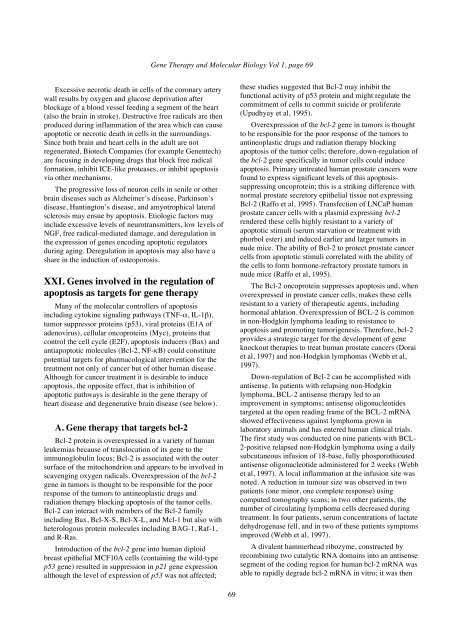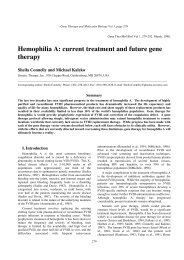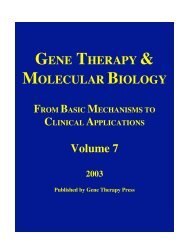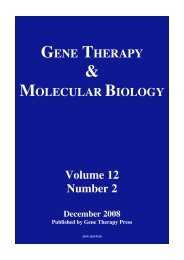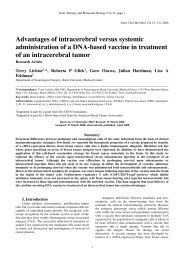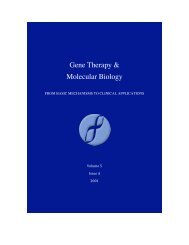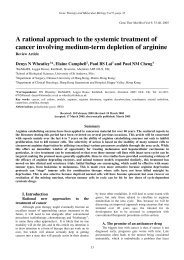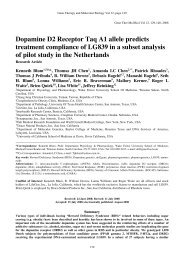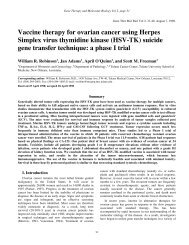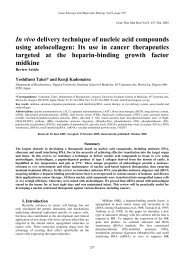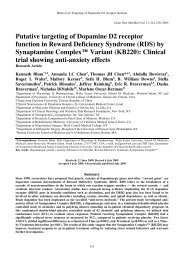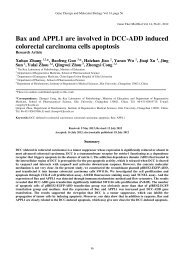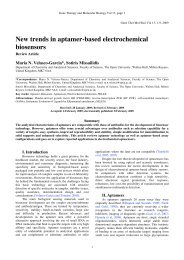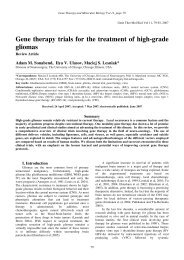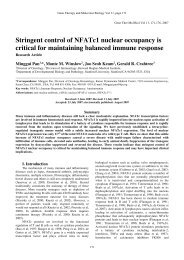01. Gene therapy Boulikas.pdf - Gene therapy & Molecular Biology
01. Gene therapy Boulikas.pdf - Gene therapy & Molecular Biology
01. Gene therapy Boulikas.pdf - Gene therapy & Molecular Biology
Create successful ePaper yourself
Turn your PDF publications into a flip-book with our unique Google optimized e-Paper software.
Excessive necrotic death in cells of the coronary artery<br />
wall results by oxygen and glucose deprivation after<br />
blockage of a blood vessel feeding a segment of the heart<br />
(also the brain in stroke). Destructive free radicals are then<br />
produced during inflammation of the area which can cause<br />
apoptotic or necrotic death in cells in the surroundings.<br />
Since both brain and heart cells in the adult are not<br />
regenerated, Biotech Companies (for example <strong>Gene</strong>ntech)<br />
are focusing in developing drugs that block free radical<br />
formation, inhibit ICE-like proteases, or inhibit apoptosis<br />
via other mechanisms.<br />
The progressive loss of neuron cells in senile or other<br />
brain diseases such as Alzheimer’s disease, Parkinson’s<br />
disease, Huntington’s disease, and amyotrophical lateral<br />
sclerosis may ensue by apoptosis. Etiologic factors may<br />
include excessive levels of neurotransmitters, low levels of<br />
NGF, free radical-mediated damage, and deregulation in<br />
the expression of genes encoding apoptotic regulators<br />
during aging. Deregulation in apoptosis may also have a<br />
share in the induction of osteoporosis.<br />
XXI. <strong>Gene</strong>s involved in the regulation of<br />
apoptosis as targets for gene <strong>therapy</strong><br />
Many of the molecular controllers of apoptosis<br />
including cytokine signaling pathways (TNF-α, IL-1β),<br />
tumor suppressor proteins (p53), viral proteins (E1A of<br />
adenovirus), cellular oncoproteins (Myc), proteins that<br />
control the cell cycle (E2F), apoptosis inducers (Bax) and<br />
antiapoptotic molecules (Bcl-2, NF-κB) could constitute<br />
potential targets for pharmacological intervention for the<br />
treatment not only of cancer but of other human disease.<br />
Although for cancer treatment it is desirable to induce<br />
apoptosis, the opposite effect, that is inhibition of<br />
apoptotic pathways is desirable in the gene <strong>therapy</strong> of<br />
heart disease and degenerative brain disease (see below).<br />
A. <strong>Gene</strong> <strong>therapy</strong> that targets bcl-2<br />
Bcl-2 protein is overexpressed in a variety of human<br />
leukemias because of translocation of its gene to the<br />
immunoglobulin locus; Bcl-2 is associated with the outer<br />
surface of the mitochondrion and appears to be involved in<br />
scavenging oxygen radicals. Overexpression of the bcl-2<br />
gene in tumors is thought to be responsible for the poor<br />
response of the tumors to antineoplastic drugs and<br />
radiation <strong>therapy</strong> blocking apoptosis of the tumor cells.<br />
Bcl-2 can interact with members of the Bcl-2 family<br />
including Bax, Bcl-X-S, Bcl-X-L, and Mcl-1 but also with<br />
heterologous protein molecules including BAG-1, Raf-1,<br />
and R-Ras.<br />
Introduction of the bcl-2 gene into human diploid<br />
breast epithelial MCF10A cells (containing the wild-type<br />
p53 gene) resulted in suppression in p21 gene expression<br />
although the level of expression of p53 was not affected;<br />
<strong>Gene</strong> Therapy and <strong>Molecular</strong> <strong>Biology</strong> Vol 1, page 69<br />
69<br />
these studies suggested that Bcl-2 may inhibit the<br />
functional activity of p53 protein and might regulate the<br />
commitment of cells to commit suicide or proliferate<br />
(Upadhyay et al, 1995).<br />
Overexpression of the bcl-2 gene in tumors is thought<br />
to be responsible for the poor response of the tumors to<br />
antineoplastic drugs and radiation <strong>therapy</strong> blocking<br />
apoptosis of the tumor cells; therefore, down-regulation of<br />
the bcl-2 gene specifically in tumor cells could induce<br />
apoptosis. Primary untreated human prostate cancers were<br />
found to express significant levels of this apoptosissuppressing<br />
oncoprotein; this is a striking difference with<br />
normal prostate secretory epithelial tissue not expressing<br />
Bcl-2 (Raffo et al, 1995). Transfection of LNCaP human<br />
prostate cancer cells with a plasmid expressing bcl-2<br />
rendered these cells highly resistant to a variety of<br />
apoptotic stimuli (serum starvation or treatment with<br />
phorbol ester) and induced earlier and larger tumors in<br />
nude mice. The ability of Bcl-2 to protect prostate cancer<br />
cells from apoptotic stimuli correlated with the ability of<br />
the cells to form hormone-refractory prostate tumors in<br />
nude mice (Raffo et al, 1995).<br />
The Bcl-2 oncoprotein suppresses apoptosis and, when<br />
overexpressed in prostate cancer cells, makes these cells<br />
resistant to a variety of therapeutic agents, including<br />
hormonal ablation. Overexpression of BCL-2 is common<br />
in non-Hodgkin lymphoma leading to resistance to<br />
apoptosis and promoting tumorigenesis. Therefore, bcl-2<br />
provides a strategic target for the development of gene<br />
knockout therapies to treat human prostate cancers (Dorai<br />
et al, 1997) and non-Hodgkin lymphomas (Webb et al,<br />
1997).<br />
Down-regulation of Bcl-2 can be accomplished with<br />
antisense. In patients with relapsing non-Hodgkin<br />
lymphoma, BCL-2 antisense <strong>therapy</strong> led to an<br />
improvement in symptoms; antisense oligonucleotides<br />
targeted at the open reading frame of the BCL-2 mRNA<br />
showed effectiveness against lymphoma grown in<br />
laboratory animals and has entered human clinical trials.<br />
The first study was conducted on nine patients with BCL-<br />
2-positive relapsed non-Hodgkin lymphoma using a daily<br />
subcutaneous infusion of 18-base, fully phosporothioated<br />
antisense oligonucleotide administered for 2 weeks (Webb<br />
et al, 1997). A local inflammation at the infusion site was<br />
noted. A reduction in tumour size was observed in two<br />
patients (one minor, one complete response) using<br />
computed tomography scans; in two other patients, the<br />
number of circulating lymphoma cells decreased during<br />
treatment. In four patients, serum concentrations of lactate<br />
dehydrogenase fell, and in two of these patients symptoms<br />
improved (Webb et al, 1997).<br />
A divalent hammerhead ribozyme, constructed by<br />
recombining two catalytic RNA domains into an antisense<br />
segment of the coding region for human bcl-2 mRNA was<br />
able to rapidly degrade bcl-2 mRNA in vitro; it was then


